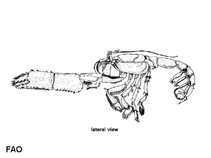Callianassa petalura Stimpson, 1860
Flower ghost shrimp
Classification / Names Common names | Synonyms | CoL | ITIS | WoRMS
Malacostraca | Decapoda | Callianassidae
Environment: milieu / climate zone / depth range / distribution range Ecology
Benthic; brackish. Subtropical; 44°N - 31°N, 116°E - 141°E (Ref. 4)
Distribution Countries | FAO areas | Ecosystems | Occurrences | Introductions
Northwest Pacific.
Length at first maturity / Size / Weight / Age
Maturity: Lm ? range ? - ? cmCommon length : 5.0 cm TL male/unsexed; (Ref. 4); common length :5 cm TL (female)
Short description Morphology
Rostrum very inconspicuous, a wide angle in the anterior margin of the carapace, overreaches the full length of the eyes. The eyes bluntly triangular or quadrangular. Antennal angle likewise inconspicuously triangular, without antennal spine. Antennular peduncle distinctly longer than the antennal peduncle, reaching beyond it with more than half the last segment. Third maxilliped with the ischium and merus expanded to form distinct operculum. Large chela of adult male with a small concavity in the anterior margin of the palm above the fixed finger. Carpus somewhat longer than the palm and longer than high. Merus with a distinct process in the basal half of the lower margin; this process produced forward, ending in a narrowing rounded top. In the females this process reduced to a small triangular tooth. Telson quadrangular slightly shorter than the uropods. The endopod of the uropod broadly triangular with rounded corners (Ref. 4).
It has total body lengths of 1.5 to 5 cm (males), 1 to 5 cm (females) and 2.8 to 5 cm (ovigerous females) (Ref. 4).
Life cycle and mating behavior Maturity | Reproduction | Spawning | Eggs | Fecundity | Larvae
Members of the order Decapoda are mostly gonochoric. Mating behavior: Precopulatory courtship ritual is common (through olfactory and tactile cues); usually indirect sperm transfer.
Main reference
References | Coordinator | Collaborators
Holthuis, L.B. 1991. (Ref. 4)
IUCN Red List Status (Ref. 130435: Version 2024-1)
CITES status (Ref. 108899)
Not Evaluated
CMS (Ref. 116361)
Not Evaluated
Threat to humans
Human uses
Fisheries: commercial
| FishSource |
Tools
More information
Trophic Ecology
Ecology
Population dynamics
Growth
Age/Size
Length-weight
Length-length
Length-frequencies
Mass conversion
Recruitment
Abundance
Age/Size
Length-weight
Length-length
Length-frequencies
Mass conversion
Recruitment
Abundance
Life cycle
Distribution
Human Related
Aquaculture profile
Stamps, Coins Misc.
Stamps, Coins Misc.
Outreach
References
Internet sources
BHL | BOLD Systems | CISTI | DiscoverLife | FAO(Publication : search) | Fishipedia | GenBank (genome, nucleotide) | GloBI | Gomexsi | Google Books | Google Scholar | Google | PubMed | Tree of Life | Wikipedia (Go, Search) | Zoological Record



